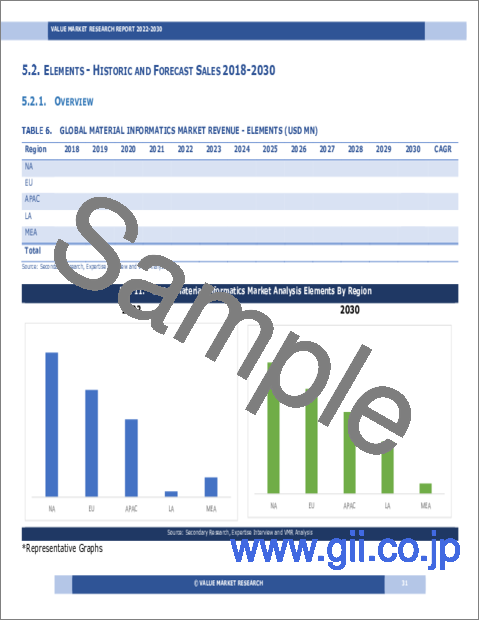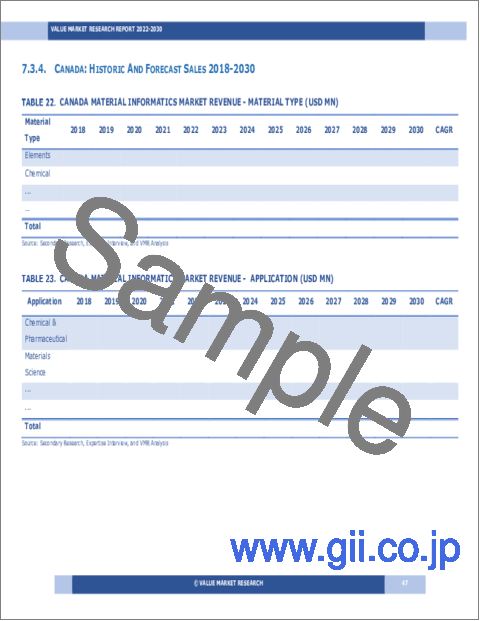|
|
市場調査レポート
商品コード
1305264
マテリアル・インフォマティクスの世界市場調査レポート:産業分析、規模、シェア、成長、動向、2023~2030年予測Global Material Informatics Market Research Report - Industry Analysis, Size, Share, Growth, Trends and Forecast 2023 to 2030 |
||||||
カスタマイズ可能
|
|||||||
| マテリアル・インフォマティクスの世界市場調査レポート:産業分析、規模、シェア、成長、動向、2023~2030年予測 |
|
出版日: 2023年06月01日
発行: Value Market Research
ページ情報: 英文 137 Pages
納期: 即日から翌営業日
|
- 全表示
- 概要
- 図表
- 目次
マテリアル・インフォマティクス市場の世界需要は、調査期間2023~2030年のCAGR17.9%で、2022年の1億332万米ドルから2030年には3億8,574万米ドル近くの市場規模に達すると推定されます。
マテリアル・インフォマティクスは、材料の発見、設計、最適化のための方法とツールを開発するために、材料科学とコンピュータ科学を組み合わせた学際的な分野です。機械学習、データマイニング、データ可視化などのデータ駆動型アプローチを用いて大規模なデータセットを分析し、材料の特性や挙動に関する有用な情報を抽出します。マテリアル・インフォマティクスは、科学者やエンジニアに材料の特性を分析・予測するための強力なツールを提供することで、新材料の開発を加速し、既存の材料の性能を向上させることを目的としています。
市場力学:
より効率的で持続可能な技術へのニーズにより、特定の特性と用途を持つ新素材への需要が急速に高まっています。マテリアル・インフォマティクスは、新材料の発見と設計を加速するのに役立ち、研究者や企業にとって魅力的な選択肢となります。新しいデータ分析と機械学習技術の開発により、大規模なデータセットを分析し、材料の特性や挙動に関する有用な情報を抽出することが可能になっています。マテリアル・インフォマティクス企業は、こうした進歩を活用して、顧客向けの高度な製品やサービスを開発しています。政府や非公開会社は、新素材の研究に投資しています。研究者が新素材の発見と設計を加速する新たな方法を模索する中、マテリアル・インフォマティクスはこうした取り組みにおいてますます重要な役割を果たしています。クラウドベースの技術の採用により、研究者や企業は世界中のどこからでも大規模なデータセットにアクセスし、分析することが容易になっています。マテリアル・インフォマティクス企業は、これらの技術を活用して、材料の特性を分析・予測するための強力なツールを顧客に提供しています。マテリアル・インフォマティクスは学際的な分野であり、学界と産業界の研究者の協力が必要です。この分野が成長し続けるにつれて、この2つのグループのコラボレーションが増え、現実世界の課題に対処する新製品やサービスの開発につながることが期待されます。
調査報告書は、ポーターのファイブフォース・モデル、市場魅力度分析、バリューチェーン分析を網羅しています。これらのツールは、業界の構造を明確に把握し、競合の魅力を世界レベルで評価するのに役立ちます。さらに、これらのツールは、マテリアル・インフォマティクスの世界市場における各セグメントを包括的に評価することもできます。マテリアル・インフォマティクス産業の成長と動向は、この調査に全体的なアプローチを提供します。
市場セグメンテーション:
この調査レポートは、マテリアル・インフォマティクスの世界市場における各セグメントを包括的に評価し、マテリアル・インフォマティクスの成長動向と市場動向を包括的に分析しています。
素材タイプ別
- 元素
- 化学
- その他
用途別
- 化学・医薬
- 材料科学
- 製造
- 食品科学
- エネルギー
- その他
地域分析
本セクションでは、北米、欧州、アジア太平洋、ラテンアメリカ、中東・アフリカにおけるマテリアル・インフォマティクス市場の現在と将来の需要を強調する地域展望をカバーします。さらに、著名な全地域における個々のアプリケーションセグメントの需要・推定・予測にも焦点を当てています。
ご要望がございましたら、弊社までご連絡ください。当社の調査チームは、お客様のニーズに応じてカスタマイズしたレポートを提供することができます。
目次
第1章 序文
第2章 エグゼクティブサマリー
- 市場のハイライト
- 世界市場スナップショット
第3章 マテリアル・インフォマティクス- 産業分析
- イントロダクション:市場力学
- 市場促進要因
- 市場抑制要因
- 市場機会
- 業界動向
- ポーターのファイブフォース分析
- 市場魅力度分析
第4章 バリューチェーン分析
- バリューチェーン分析
- 原材料分析
- 原材料リスト
- 原材料メーカーリスト
- 主要原材料の価格動向
- 潜在的バイヤーリスト
- マーケティングチャネル
- ダイレクトマーケティング
- インダイレクトマーケティング
- マーケティングチャネル発展動向
第5章 マテリアル・インフォマティクスの世界市場分析:素材タイプ別
- 素材タイプ別概要
- 実績データと予測データ
- 素材タイプ別分析
- 元素
- ケミカル
- その他
第6章 マテリアル・インフォマティクスの世界市場分析:用途別
- 概要:アプリケーション別
- 実績データと予測データ
- 分析:アプリケーション別
- 化学・製薬
- 材料科学
- 製造業
- 食品科学
- エネルギー
- その他
第7章 マテリアル・インフォマティクスの世界市場分析:地域別
- 地域別展望
- イントロダクション
- 北米の売上分析
- 概要、実績および予測
- 北米:セグメント別
- 北米:国別
- 米国
- カナダ
- メキシコ
- 欧州の売上分析
- 概要、実績および予測
- 欧州:セグメント別
- 欧州:国別
- 英国
- フランス
- ドイツ
- イタリア
- ロシア
- その他欧州
- アジア太平洋地域売上分析
- 概要、実績および予測
- アジア太平洋地域:セグメント別
- アジア太平洋地域:国別
- 中国
- インド
- 日本
- 韓国
- オーストラリア
- その他アジア太平洋地域
- ラテンアメリカ売上分析
- 概要、実績および予測
- ラテンアメリカ:セグメント別
- ラテンアメリカ:国別
- ブラジル
- アルゼンチン
- ペルー
- チリ
- その他ラテンアメリカ
- 中東・アフリカ売上分析
- 概要、実績および予測
- 中東・アフリカ:セグメント別
- 中東・アフリカ:国別
- サウジアラビア
- アラブ首長国連邦
- イスラエル
- 南アフリカ
- その他中東とアフリカ
第8章 マテリアル・インフォマティクス企業の競合情勢
- マテリアル・インフォマティクス市場の競合
- 提携/協力/合意
- 合併・買収
- 新製品の発売
- その他の開発
第9章 企業プロファイル
- 上位企業の市場シェア分析
- 市場集中度
- Mat3ra
- Schrodinger
- Dassault Systemes
- Citrine informatics
- Phaseshift Technologies
注-企業プロファイルにおいて、財務の詳細や最近の動向は、非公開会社の場合、入手可能であるか、またはカバーされていない場合があります。
LIST OF TABLES
- Market Snapshot
- Drivers : Impact Analysis
- Restraints : Impact Analysis
- List of Raw Material
- List of Raw Material Manufactures
- List of Potential Buyers
- Analysis by Material Type (USD MN)
- Elements Market Sales by Geography (USD MN)
- Chemical Market Sales by Geography (USD MN)
- Others Market Sales by Geography (USD MN)
- Analysis Market by Application (USD MN)
- Chemical & Pharmaceutical Market Sales by Geography (USD MN)
- Materials Science Market Sales by Geography (USD MN)
- Manufacturing Market Sales by Geography (USD MN)
- Food Science Market Sales by Geography (USD MN)
- Energy Market Sales by Geography (USD MN)
- Others Market Sales by Geography (USD MN)
- Global Material Informatics Market Sales by Geography (USD MN)
- North America Market Analysis (USD MN)
- United State Market Analysis (USD MN)
- Canada Market Analysis (USD MN)
- Mexico Market Analysis (USD MN)
- Europe Market Analysis (USD MN)
- Europe Market Estimate by Country (USD MN)
- United Kingdom Market Analysis (USD MN)
- France Market Analysis (USD MN)
- Germany Market Analysis (USD MN)
- Italy Market Analysis (USD MN)
- Russia Market Analysis (USD MN)
- Spain Market Analysis (USD MN)
- Rest of Europe Market Analysis (USD MN)
- Asia Pacific Market Analysis (USD MN)
- China Market Analysis (USD MN)
- Japan Market Analysis (USD MN)
- India Market Analysis (USD MN)
- South Korea Market Analysis (USD MN)
- Australia Market Analysis (USD MN)
- Rest of Asia Pacific Market Analysis (USD MN)
- Latin America Market Analysis (USD MN)
- Brazil Market Analysis (USD MN)
- Argentina Market Analysis (USD MN)
- Peru Market Analysis (USD MN)
- Chile Market Analysis (USD MN)
- Rest of Latin America Market Analysis (USD MN)
- Middle East & Africa Market Analysis (USD MN)
- Saudi Arabia Market Analysis (USD MN)
- UAE Market Analysis (USD MN)
- Israel Market Analysis (USD MN)
- South Africa Market Analysis (USD MN)
- Rest of Middle East and Africa Market Analysis (USD MN)
- Partnership/Collaboration/Agreement
- Mergers And Acquisition
LIST OF FIGURES
- Research Scope of Material Informatics Report
- Market Research Process
- Market Research Methodology
- Global Material Informatics Market Size, by Region (USD MN)
- Porters Five Forces Analysis
- Market Attractiveness Analysis by Material Type
- Market Attractiveness Analysis by Application
- Market Attractiveness Analysis by Region
- Value Chain Analysis
- Global Market Analysis by Material Type (USD MN)
- Elements Market Sales by Geography (USD MN)
- Chemical Market Sales by Geography (USD MN)
- Others Market Sales by Geography (USD MN)
- Global Market Analysis by Application (USD MN)
- Chemical & Pharmaceutical Market Sales by Geography (USD MN)
- Materials Science Market Sales by Geography (USD MN)
- Manufacturing Market Sales by Geography (USD MN)
- Food Science Market Sales by Geography (USD MN)
- Energy Market Sales by Geography (USD MN)
- Others Market Sales by Geography (USD MN)
- Global Market Sales (USD MN)
- North America Market Sales (USD MN)
- Europe Market Sales (USD MN)
- Asia Pacific Market Sales (USD MN)
- Latin America Market Sales (USD MN)
- Middle East & Africa Market Sales (USD MN)
- Recent Development in Industry
- Top Companies Market Share Analysis
Kindly note that the above listed are the basic tables and figures of the report and are not limited to the TOC.
The global demand for Material Informatics Market is presumed to reach the market size of nearly USD 385.74 MN by 2030 from USD 103.32 MN in 2022 with a CAGR of 17.9% under the study period 2023 - 2030.
Material informatics is an interdisciplinary field that combines materials science and computer science to develop methods and tools for the discovery, design, and optimization of materials. It involves the use of data-driven approaches, including machine learning, data mining, and data visualization, to analyze large datasets and extract useful information about the properties and behaviour of materials. Material informatics aims to accelerate the development of new materials and improve the performance of existing ones by providing scientists and engineers with powerful tools for analyzing and predicting the properties of materials.
Market Dynamics:
The demand for new materials with specific properties and applications is increasing rapidly, driven by the need for more efficient and sustainable technologies. Material informatics can help to accelerate the discovery and design of new materials, making it an attractive option for researchers and companies. The development of new data analytics and machine learning techniques is making it possible to analyze large datasets and extract useful information about the properties and behaviour of materials. Material informatics companies are leveraging these advances to develop advanced products and services for their customers. Governments and private companies are investing in the research of new materials. Material informatics is playing an increasingly important role in these efforts as researchers look for new ways to accelerate the discovery and design of new materials. The adoption of cloud-based technologies is making it easier for researchers and companies to access and analyze large datasets from anywhere in the world. Material informatics companies are leveraging these technologies to provide their customers with powerful tools for analyzing and predicting the properties of materials. Material informatics is an interdisciplinary field that requires collaboration between researchers in academia and industry. As the field continues to grow, we can expect to see more collaborations between these two groups, leading to the development of new products and services that address real-world challenges.
The research report covers Porter's Five Forces Model, Market Attractiveness Analysis, and Value Chain analysis. These tools help to get a clear picture of the industry's structure and evaluate the competition attractiveness at a global level. Additionally, these tools also give an inclusive assessment of each segment in the global market of material informatics. The growth and trends of material informatics industry provide a holistic approach to this study.
Market Segmentation:
This section of the material informatics market report provides detailed data on the segments at country and regional level, thereby assisting the strategist in identifying the target demographics for the respective product or services with the upcoming opportunities.
By Material Type
- Elements
- Chemical
- Others
By Application
- Chemical & Pharmaceutical
- Materials Science
- Manufacturing
- Food Science
- Energy
- Others
Regional Analysis
This section covers the regional outlook, which accentuates current and future demand for the Material Informatics market across North America, Europe, Asia-Pacific, Latin America, and Middle East & Africa. Further, the report focuses on demand, estimation, and forecast for individual application segments across all the prominent regions.
The research report also covers the comprehensive profiles of the key players in the market and an in-depth view of the competitive landscape worldwide. The major players in the material informatics market include Mat3ra, Schrodinger, Dassault Systemes, Citrine informatics, Phaseshift Technologies. This section consists of a holistic view of the competitive landscape that includes various strategic developments such as key mergers & acquisitions, future capacities, partnerships, financial overviews, collaborations, new product developments, new product launches, and other developments.
In case you have any custom requirements, do write to us. Our research team can offer a customized report as per your need.
TABLE OF CONTENTS
1 . PREFACE
- 1.1. Report Description
- 1.1.1. Objective
- 1.1.2. Target Audience
- 1.1.3. Unique Selling Proposition (USP) & offerings
- 1.2. Research Scope
- 1.3. Research Methodology
- 1.3.1. Market Research Process
- 1.3.2. Market Research Methodology
2 . EXECUTIVE SUMMARY
- 2.1. Highlights of Market
- 2.2. Global Market Snapshot
3 . MATERIAL INFORMATICS - INDUSTRY ANALYSIS
- 3.1. Introduction - Market Dynamics
- 3.2. Market Drivers
- 3.3. Market Restraints
- 3.4. Opportunities
- 3.5. Industry Trends
- 3.6. Porter's Five Force Analysis
- 3.7. Market Attractiveness Analysis
- 3.7.1 Market Attractiveness Analysis By Material Type
- 3.7.2 Market Attractiveness Analysis By Application
- 3.7.3 Market Attractiveness Analysis By Region
4 . VALUE CHAIN ANALYSIS
- 4.1. Value Chain Analysis
- 4.2. Raw Material Analysis
- 4.2.1. List of Raw Materials
- 4.2.2. Raw Material Manufactures List
- 4.2.3. Price Trend of Key Raw Materials
- 4.3. List of Potential Buyers
- 4.4. Marketing Channel
- 4.4.1. Direct Marketing
- 4.4.2. Indirect Marketing
- 4.4.3. Marketing Channel Development Trend
5 . GLOBAL MATERIAL INFORMATICS MARKET ANALYSIS BY MATERIAL TYPE
- 5.1 Overview by Material Type
- 5.2 Historical and Forecast Data
- 5.3 Analysis by Material Type
- 5.4 Elements Historic and Forecast Sales by Regions
- 5.5 Chemical Historic and Forecast Sales by Regions
- 5.6 Others Historic and Forecast Sales by Regions
6 . GLOBAL MATERIAL INFORMATICS MARKET ANALYSIS BY APPLICATION
- 6.1 Overview by Application
- 6.2 Historical and Forecast Data
- 6.3 Analysis by Application
- 6.4 Chemical & Pharmaceutical Historic and Forecast Sales by Regions
- 6.5 Materials Science Historic and Forecast Sales by Regions
- 6.6 Manufacturing Historic and Forecast Sales by Regions
- 6.7 Food Science Historic and Forecast Sales by Regions
- 6.8 Energy Historic and Forecast Sales by Regions
- 6.9 Others Historic and Forecast Sales by Regions
7 . GLOBAL MATERIAL INFORMATICS MARKET ANALYSIS BY GEOGRAPHY
- 7.1. Regional Outlook
- 7.2. Introduction
- 7.3. North America Sales Analysis
- 7.3.1. Overview, Historic and Forecast Data Sales Analysis
- 7.3.2. North America By Segment Sales Analysis
- 7.3.3. North America By Country Sales Analysis
- 7.3.4. United State Sales Analysis
- 7.3.5. Canada Sales Analysis
- 7.3.6. Mexico Sales Analysis
- 7.4. Europe Sales Analysis
- 7.4.1. Overview, Historic and Forecast Data Sales Analysis
- 7.4.2. Europe by Segment Sales Analysis
- 7.4.3. Europe by Country Sales Analysis
- 7.4.4. United Kingdom Sales Analysis
- 7.4.5. France Sales Analysis
- 7.4.6. Germany Sales Analysis
- 7.4.7. Italy Sales Analysis
- 7.4.8. Russia Sales Analysis
- 7.4.9. Rest Of Europe Sales Analysis
- 7.5. Asia Pacific Sales Analysis
- 7.5.1. Overview, Historic and Forecast Data Sales Analysis
- 7.5.2. Asia Pacific by Segment Sales Analysis
- 7.5.3. Asia Pacific by Country Sales Analysis
- 7.5.4. China Sales Analysis
- 7.5.5. India Sales Analysis
- 7.5.6. Japan Sales Analysis
- 7.5.7. South Korea Sales Analysis
- 7.5.8. Australia Sales Analysis
- 7.5.9. Rest Of Asia Pacific Sales Analysis
- 7.6. Latin America Sales Analysis
- 7.6.1. Overview, Historic and Forecast Data Sales Analysis
- 7.6.2. Latin America by Segment Sales Analysis
- 7.6.3. Latin America by Country Sales Analysis
- 7.6.4. Brazil Sales Analysis
- 7.6.5. Argentina Sales Analysis
- 7.6.6. Peru Sales Analysis
- 7.6.7. Chile Sales Analysis
- 7.6.8. Rest of Latin America Sales Analysis
- 7.7. Middle East & Africa Sales Analysis
- 7.7.1. Overview, Historic and Forecast Data Sales Analysis
- 7.7.2. Middle East & Africa by Segment Sales Analysis
- 7.7.3. Middle East & Africa by Country Sales Analysis
- 7.7.4. Saudi Arabia Sales Analysis
- 7.7.5. UAE Sales Analysis
- 7.7.6. Israel Sales Analysis
- 7.7.7. South Africa Sales Analysis
- 7.7.8. Rest Of Middle East And Africa Sales Analysis
8 . COMPETITIVE LANDSCAPE OF THE MATERIAL INFORMATICS COMPANIES
- 8.1. Material Informatics Market Competition
- 8.2. Partnership/Collaboration/Agreement
- 8.3. Merger And Acquisitions
- 8.4. New Product Launch
- 8.5. Other Developments
9 . COMPANY PROFILES OF MATERIAL INFORMATICS INDUSTRY
- 9.1. Top Companies Market Share Analysis
- 9.2. Market Concentration Rate
- 9.3. Mat3ra
- 9.3.1. Company Overview
- 9.3.2. Company Revenue
- 9.3.3. Products
- 9.3.4. Recent Developments
- 9.4. Schrodinger
- 9.4.1. Company Overview
- 9.4.2. Company Revenue
- 9.4.3. Products
- 9.4.4. Recent Developments
- 9.5. Dassault Systemes
- 9.5.1. Company Overview
- 9.5.2. Company Revenue
- 9.5.3. Products
- 9.5.4. Recent Developments
- 9.6. Citrine informatics
- 9.6.1. Company Overview
- 9.6.2. Company Revenue
- 9.6.3. Products
- 9.6.4. Recent Developments
- 9.7. Phaseshift Technologies
- 9.7.1. Company Overview
- 9.7.2. Company Revenue
- 9.7.3. Products
- 9.7.4. Recent Developments
Note - in company profiling, financial details and recent development are subject to availability or might not be covered in case of private companies





